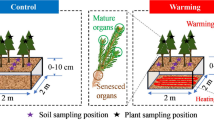Abstract
We studied the nutrient cycle of a planted forest of Pinus tabulaeformis in the Miyun Reservoir Watershed, Beijing. Results show that the total biomass of P. tabulaeformis stands at age 29 in the experimental area is 92627 kg/hm2, and the total nutrient store is 695.17 kg/hm2 including nitrogen (N), phosphorus (P), kalium (K), calium (Ca) and magnesium (Mg). The sequence of their contents in different organs was given as follows: needle>branch> trunk>root. The annual amount of 85.37 kg/hm2 of five nutrient elements were assimilated by P. tabulaeformis, about 0.34% of the total store in soil, and 3.30% of available nutrient store in soil depth from 0 to 30 cm. The nutrient annual retention is 35.92 kg/hm2, annual returning 49.46 kg/hm2, the rain input 26.04 kg/hm2 to the five nutrient elements. The parameter absorption coefficient, utilization coefficient, cycle coefficient and turnover period were cited to describe the nutrient elements cycle characteristic of the planted forest ecosystem of P. tabulaeformis. The absorption coefficient is the ratio of plant nutrient element content to soil nutrient element content, and its sequence of five nutrient elements was given as follows: N>P>K>Ca>Mg. Utilization coefficient is the ratio of the nutrient element annual uptake amount to the nutrient element storage in standing crops, and its sequence of five nutrient elements was: Mg>K> P>N>Ca. The big utilization coefficient means more nutrients stored in the plant. The cycle coefficient is the ratio of the nutrient element annual return amount to the nutrient element annual uptake amount, its sequence: Ca>N>P>K>Mg. Turnover period is the ratio of the nutrient storage in the crops to the annual returning, its sequence: Mg>K>P>N>Ca.
Similar content being viewed by others
References
Bernard T B (1993). Rapid N fixation in pines, alder, and locust: evidence from the sandbox ecosystem study. Ecology, 74(2): 538–598
Chen L Z, Hu Y H, Kong F Z (1987). The chemical elements of planted forest of Pinus tabulaeformis. Acta Bot Sin, 29(3): 302–308 (in Chinese)
Dong M, Wang Y F, Kong F Z (1996). Survey, Observation and Analysis of Terrestrial Biocmmunities. Beijing: Standards Press of China (in Chinese)
Lin P, He J Y, Li Z J (1998). Wuyishan Research Series Forest Ecosystem (I). Xiamen: Xiamen University Press (in Chinese)
Liu G Q, Tu X N, Zhao S T (2001a). Degradation and control of soil organic matter and nutrient elements of pine-Quercus liaotungensis forest in MT, Qingling. Sci Silv Sin, 37(1): 28–36 (in Chinese)
Liu G S, Jiang N H, Zhang L D (1996). Soil Physical and Chemical Analysis Description of Soil Profiles. Beijing: Standards Press of China (in Chinese)
Liu S H, Yu X X, Yu Z M (2001b). Property of precipitation of chemical elements of the Pinus tabulaeformis water resource protection forest in the Miyun reservoir watershed. Chin J App Ecol, 12(5): 697–700 (in Chinese)
Shen G F, Dong S R, Nie D P (1985). Studies on the nutrient element cycling in the Pinus tabulaeformis plantation I, Content and distribution of nutrient elements. J Beijing For Univ, 7(4): 1–14 (in Chinese)
Wang G H (2002). Plant traits and soil chemical variable during a secondary vegetation succession in abandoned filed on the Loess Plateau. Acta Bot Sin, 44(8): 990–998 (in Chinese)
Wu Z Y (1980). Vegetation of China. Beijing: Science Press (in Chinese)
Xie X Q, Wang L J, Wang S S (1998). Observation and Analysis of Water Environment Factors. Beijing: Standards Press of China, 100–294 (in Chinese)
Yan C R, Wang Y F, Huang J H (1993). A study on nutrient cycling of pine stands in eastern part of China. Acta Phytoecol Sin, 23(4): 351–360 (in Chinese)
Yu X X, Yu Z M, Wang L X (2001). Forest for Water Resources Protection Silviculture, Management and Evaluation. Beijing: China Forestry Publishing House (in Chinese)
Zhang X B, Shangguan Z P (2006). Nutrient distributions and bio-cycle patterns in both natural and artificial Pinus tabulaeformis forests in hilly loess regions. Acta Ecol Sin, 26(2): 373–382 (in Chinese)
Author information
Authors and Affiliations
Corresponding author
Additional information
__________
Translated from Journal of Beijing Forestry University, 2008, 30(3): 51–56 [译自: 北京林业大学学报]
About this article
Cite this article
Liu, S., Yu, X. Nutrient cycle of planted forest of Pinus tabulaeformis in the Miyun Reservoir Watershed, Beijing. Front. For. China 4, 46–52 (2009). https://doi.org/10.1007/s11461-009-0019-1
Published:
Issue Date:
DOI: https://doi.org/10.1007/s11461-009-0019-1




